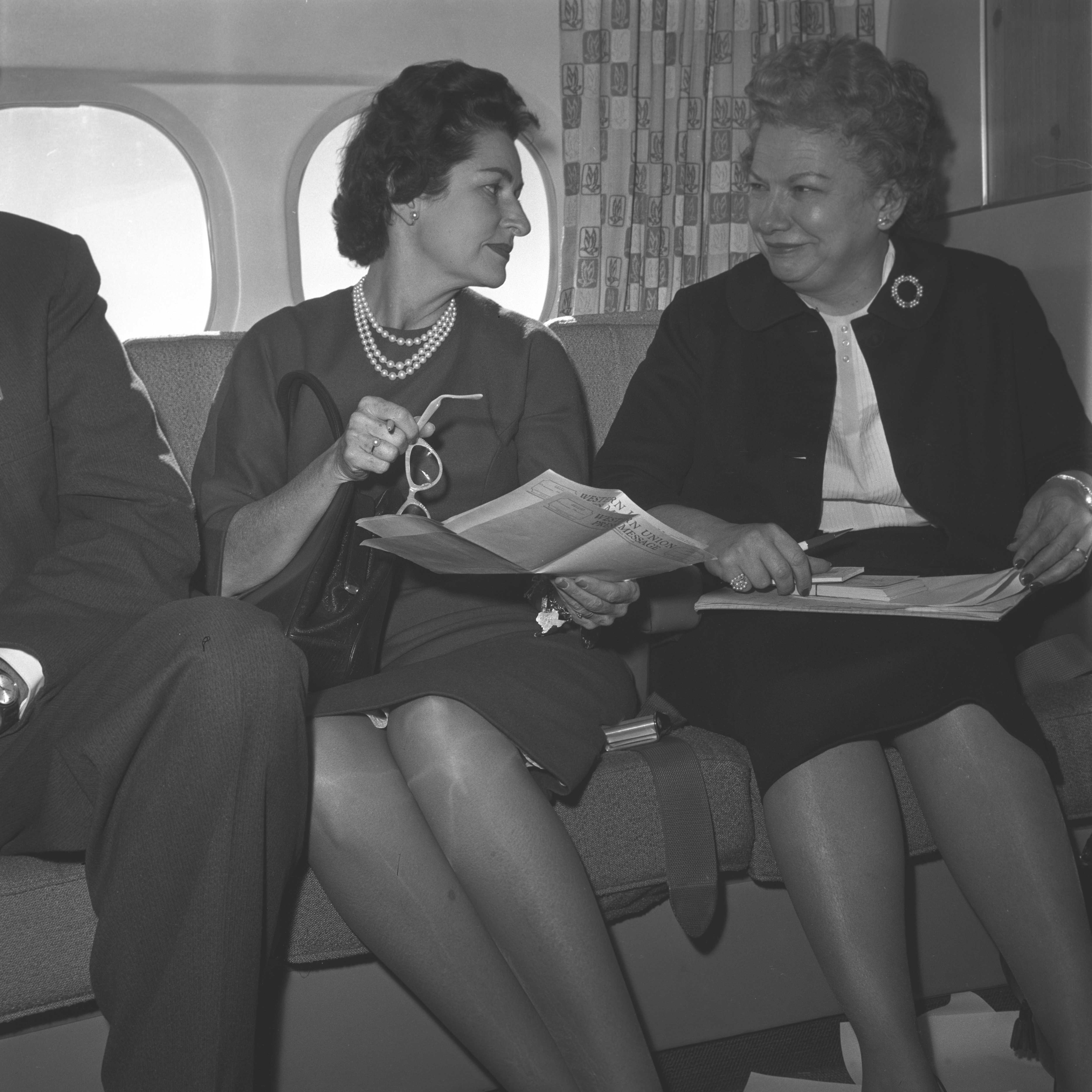Liz Carpenter was a force of nature who, throughout her 89 years (1920-2010), was often front and center where history was unfolding. leaving her own indelible mark on events. She was a journalist, White House official, Women’s Rights activist, best-selling author, and humorist. Directors Christy Carpenter, Liz’s daughter, and Abby Ginzberg weave candid modern-day interviews with Dan Rather, Bill Moyers, Gloria Steinem, Luci Johnson and others into an entertaining and informative 77-minute World Premiere that took place at the Zach Theatre on March 10th at SXSW 2024.

Liz Carpenter in action.


Born in Salado, Texas, five days after the 19th Amendment to the US Constitution granted women the right to vote in 1920, Liz’s family moved to Austin, the state capitol, when she was 7 years old. She earned a journalism degree from the University of Texas in 1942 and headed straight to Washington, DC, intent on starting her journalism career in the midst of WWII. .
At 22 years of age, she was attending press conferences held by both President Franklin and First Lady Eleanor Roosevelt despite barriers against allowing women reporters to be present.
SUPPORTING LBJ
She began covering the political rise of Congressman Lyndon Johnson for the Austin American-Statesman. This developed into a lifelong friendship with LBJ and his wife Lady Bird.
Liz’s reputation as a dogged reporter quickly spread and, by the late 1940s, she and husband Leslie Carpenter established the Carpenter News Bureau. They covered Capitol Hill and the White House for more than a dozen newspapers. She was also known as “the funniest woman in Washington, D.C.,” which made her an in-demand speaker.
In 1954, she was elected president of the Women’s National Press Club, a platform she used to attack barriers to participation in the males-only National Press Club, the foremost journalistic organization in Washington D.C..
LIZ AND JFK’S ASSASSINATION

Christy Carpenter, daughter of Liz Carpenter and co-director of “Shaking It Up: The Life and Times of Liz Carpenter” at SXSW.
In 1960, Senate Majority Leader Lyndon Johnson and Lady Bird persuaded Liz to join his campaign for vice president. Once elected, LBJ convinced Liz to join his staff as the highest-ranking woman ever to work for a vice president. Liz Carpenter was one of a small number of his staff traveling with him to Dallas on November 22, 1963. She was riding in the motorcade, in a car behind JFK’s, when President John Fitzgerald Kennedy was assassinated.
Carpenter realized she was the only writer on LBJ’s staff aboard Air Force One. On the return trip to Washington she crafted the newly sworn-in President’s first public remarks to a shocked world. LBJ delivered these 58 words, written by Liz while on the plane, upon landing and that footage is included in the documentary:
“This is a sad time for all people. We have suffered a loss that cannot be weighed. For me, it is a deep personal tragedy. I know that the world shares the sorrow that Mrs. Kennedy and her family bear. I will do my best. That is all I can do. I ask for your help and God’s.”
The archival footage of the delivery of these remarks is historic.
BEAUTIFY AMERICA
Liz was appointed st aff director and press secretary to the new First Lady.
Although Lady Bird and Liz had very different personal styles, they were both women of action and vision, and together, over the next five years, they pursued an aggressive agenda including, “the most ambitious national environmental effort since Theodore Roosevelt,” according to Lady Bird biographer Julia Sweig. (I can still do a pretty fair imitation of Lady Bird Johnson saying, “Plant a tree, a shrub, or a bush,” with the Texas twang on ‘bush,'”—fodder for comediennes of the era.) The ubiquitous campaign to remove blighted highway billboards and beautify America by planting vegetation became a trademark of Lady Bird’s. A lake and park in Austin in her name perpetuate her legacy.
WAR ON POVERTY
Liz enabled Lady Bird to put a human face on LBJ’s War on Poverty by organizing strategic press tours of Head Start and Job Corps programs across the nation. My mother was then a kindergarten teacher in a small Iowa town. She fought tirelessly for the Head Start program, which, gave disadvantaged youngsters from minority and poorer homes an equal starting point with other 5-year-olds entering the system.
Liz was sometimes dubbed the “P.T. Barnum of the White House,” and was the key mastermind of Lady Bird’s historic and unprecedented Whistlestop campaign tour through the South during the 1964 presidential campaign. In the immediate aftermath of the passage of the Civil Rights Act of 1964, Southern states were often far from welcoming to the wife of the man who had given Black citizens in the South the right to vote and a leg up on equal rights under the laws of the land.
AFTER THE WHITE HOUSE

Abby Ginzberg, co-director of “Shaking It Up: The Life and Times of Liz Carpenter” at SXSW on March 10, 2024.
After Johnson’s presidency ended in 1969, (with a populist anti-war backlash against Vietnam that saw my generation in the streets chanting “Hey! Hey! LBJ! How many kids did you kill today?”), Liz wrote a best-selling book about her White House years, entitled Ruffles & Flourishes. She would write other best-sellers, utilizing her storied wit and her historic experiences in government.
WOMEN’S MOVEMENT
Liz Carpenter got heavily involved in the growing Women’s Movement – a cause that would consume much of her time and energy until the end of her life at the age of 90 in 2010. Bill Clinton appointed her to serve on the White House Council on Aging.
In 1971, she joined feminist leaders such as Betty Friedan, Gloria Steinem, Congresswomen Bella Abzug, and Shirley Chisholm, to co-found a new organization, the National Women’s Political Caucus. This was a nationwide effort to elect more women to public office, eliminate discrimination, and to push forward legislation to improve the lives of women. Soon Liz was campaigning across the nation, stirring up voters to elect women candidates.
THE ERA
Some fifty years after its introduction, the Equal Rights Amendment (ERA) finally sailed through Congress in 1972 with huge bipartisan majorities, says the documentary. (*I still have my ERA bracelet in a drawer somewhere, along with the POW bracelet of a U.S. soldier MIA in action from that era.) Sadly, however, after many early successes on the state level, the momentum for ratification began to hit speed bumps. That is putting it mildly.
PHYLLIS SCHLAFLY & EAGLE FORUM

Activist Phyllis Schlafly wearing a “Stop ERA” badge, demonstrating with other women against the Equal Rights Amendment in front of the White House, Washington, D.C.
The film doesn’t dwell much on Phyllis Schlafly and her Eagle Forum organization, but it should. That is my one criticism of this documentary. It was Phyllis Schlafly and her anti-equal-rights work compiling lists of ultra-Conservative prominent women and men who were against the ERA that defeated it. Schlafly—who had her own political agenda—smeared the entire equal rights movement as a ploy for lesbians and women libbers and an anti-family movement. That was, at best, an over-generalization, a technique often used by the GOP to gloss over the realities of issues and, at worst, a hypocritical smear job. (*See “the border issue” in 2024). Although I realize that Phyllis Schlafly’s anti-ERA work merits an entire documentary of its own, I think she should at least have been mentioned in this one, as that opponent of the ERA kept it from passing nationwide and has left it mired in oblivion.
Donald Trump’s early organizational work involved getting those lists from the Schlafly organization, which had painted a biased picture of the efforts to achieve equality for women as being “a bunch of women’s libbers bent on destroying the family,” an untrue characterization.Liz Carpenter was called on to co-chair a new organization in 1976 – ERAmerica –focused on ratification by the last hold-out states. She spent several years lobbying states’ legislators, and governors, and galvanizing grassroots support. (It didn’t work.)
LIZ’s HUMOR
One important key to Liz’s success was her dynamic, magnetic personality, including her well-developed sense of humor — reflecting her pioneer roots and Texas-sized, can-do moxie. Humor was always integral to her identity and effectiveness. Like other recognizable Texas women such as Governor Ann Richards and journalist Molly Ivins, Liz was high-energy and innately funny, with a knack for shaking things up. Her life was spent trying to create a more just, democratic, beautiful and humane world.
CONCLUSION:
The archival clips, alone, are worth seeing this well-done documentary. It is a slice of 60s, 70s, 80s and 90s life and history. It details efforts— some successful, some futile— to advance equality for women world-wide, battles that Liz Carpenter helped lead.
While I have a few reservations about soft-pedaling the tactics of the opposition faced in the seemingly never-ending struggle for equality that women in the United States and the world face, this fine film goes a long way to showing how it can be done, if enough courageous, influential women remember Ruth Bader Ginsberg’s line, “And yet she persists.” See this one if, like me, you lived through it. If you didn’t, you need the history lesson,
























 named Ricardo pointed out that buying into the then-new Royal Islander would give us almost 30 years of time before Mexico took it back, while the Mayan clock had been ticking for a while. He was right.
named Ricardo pointed out that buying into the then-new Royal Islander would give us almost 30 years of time before Mexico took it back, while the Mayan clock had been ticking for a while. He was right. some photos. Enjoy.
some photos. Enjoy.









































